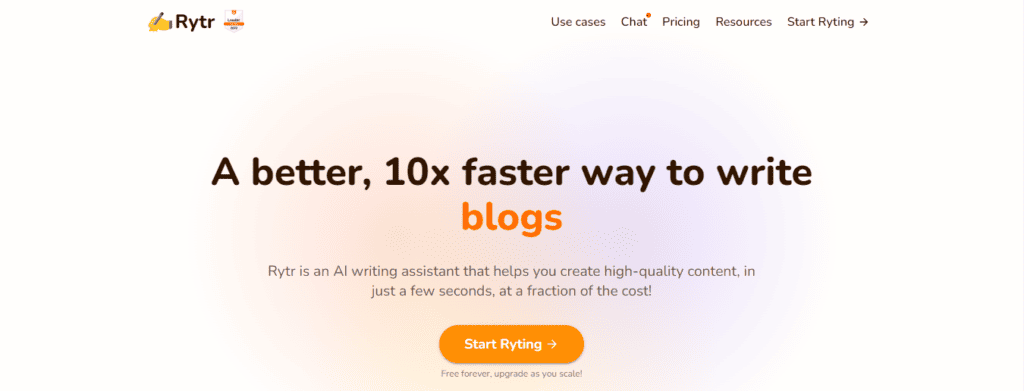Comment utiliser les outils d'écriture d'IA pour créer du contenu (2024)
We’re a quarter of the way into the 21st century and AI has changed how we write. Advancements in AI have led to it being able to craft human-like text from simple inputs.
AI writing tools have emerged as a game-changer for content creators looking to quicken their writing process and improve the quality of their content. These tools use advanced algorithms to generate text, assist in editing, and enhance the overall writing experience.
As much as you may have heard about AI writers, you could still be wondering how they can work for you. That’s why I wrote this article which explores how to use AI writing tools effectively, whether you’re a newbie content writer or have experience but need to écrire plus vite.
It covers everything from choosing the right tool to incorporating AI into your writing workflow. I’ll also provide some best practices and tips to help you maximize the possibilities of these powerful tools.
Comment fonctionnent les outils d’écriture d’IA ?
AI writing tools utilize a combination of natural language processing (NLP) and machine learning algorithms to create content. These tools are trained on extensive data, including books, articles, and other written materials, to analyze language patterns, grammar rules, and writing styles.
Based on the training, AI writing tools can understand the context of a given prompt to generate relevant and accurate content. What happens is that they read the input text and identify keywords in it to ensure that the resulting output is contextually appropriate.
The thing about AI writers is that they can continuously learn and improve through user feedback. While using any AI tool, the output can either satisfy your needs or fail to.
If the generated outcome needs to be more accurate and you report it or say anything about it not meeting your expectations, the AI model takes notes. It does so to ensure more accuracy and effectiveness in the future.
Types of Content to Write Using AI
AI writing tools can help you write a variety of content, including the following:
- Blog content: You can use AI writers to craft various elements of your blog posts. These include titles, outlines, paragraphs, and meta descriptions.
- Marketing copy: AI can also help you write promotional content, such as emails, product descriptions, social media posts, landing pages, and ad copy.
- Literary works or creative writing: If you didn’t know, it’s possible to craft literary works like book chapters, poems, and lyrics. You can also generate scripts for videos and movies.
- Academic writing: While this is considered plagiarism or cheating, students can still use AI for writing essays, reports, and book reviews.
How Do You Use AI to Write Content?
Now, below are the steps to use AI for writing.
1. Choose the Right AI Writing Tool
The AI writer you choose determines the quality of the content you get. If you choose a free tool, the quality level won’t be the same as a premium one that requires a subscription.
You can start by conducting thorough research on the various AI writing tools available in the market. Look for reputable and well-established tools with a proven track record of delivering quality results.
Features and pricing should help you decide which tool best suits your goals. Some tools may specialize in specific types of writing like copywriting, while others may offer a broader range of capabilities.
Other aspects to consider are ease of use, customization options, and integration capabilities. You’ll need a tool that’s easy to learn how to use and can connect with your existing platforms (like document editors) for enhanced workflows.
Now, you don’t have to worry because I’ve written about les meilleurs outils d'écriture d'IA before that you can check out. I cover things like their functionalities, costs, and more.
Still, here’s a quick overview of the top recommended AI tools for writing:
Jaspe

Jaspe was among the first AI tools that could generate short-form and lengthy texts. You can use Jasper to write an entire blog post in around 20 minutes.
It has an automatic blog post creation template for this purpose. Aside from blog content, there are dozens of other AI templates on Jasper for writing anything you need.
On top of that, Jasper offers an AI chat assistant that allows you to get any text-based assistance. You can ask the chatbot to write any text, paraphrase, or summarize something for you.
You could also utilize Jasper Art, the art generator tool that can create realistic images, paintings, and sketches. These AI-generated visuals can be a great complement to your writing.
Écrit sonique

Écrit sonique is another AI writer that can craft SEO-friendly content for blogs, Google ads, and other online platforms. What makes this tool unique is its focus on facts and trendiness.
Many other AI tools struggle to create factual and up-to-date text. But with Writesonic, you can get the most recent data from Google.
Writesonic also comes with Chatsonic, an AI chatbot that you can use to generate text and images right away. It produces updated responses and allows you to extract useful insights and summaries from documents like PDFs.
Rytr

The next great tool that you can choose is Rytr. With Rytr, you can write blogs and marketing content in various tones within seconds.
Rytr is great for copywriting because it comes with several frameworks that have been proven to help with conversions. These include AIDA (Attention, Interest, Desire, Action) and PAS (Problem, Agitate, Solution).
If you’re looking to rank your content, the good news is that Rytr also focuses on SEO-friendliness. It has an SEO analyzer for finding the most applicable keywords for your blog outlines and content.
2. Pick an AI Template
Once you’ve chosen an AI writing tool that suits your needs, the next step is to pick an appropriate AI template within the tool. AI templates are pre-designed structures or frameworks that can guide the content generation process.
All you need to do is determine the type of content you want to create. It could be a blog post, article, or social media caption. You then have to look for AI templates specifically designed for that content type to ensure the generated content aligns with your goals.
Most templates come with a clear structure and formula for writing specified content. You don’t have to worry about the result being too long or too short or lacking specific elements that define the content type.
3. Enter Your Input
After you’ve picked an appropriate AI template, the next step is to enter your input or prompt into the tool. Here’s how you can effectively provide input to get the desired output:
- Clear and specific prompt: You have to clearly define the topic, description, purpose, intended audience, and any specific requirements or guidelines you have for the content. The more specific and detailed your prompt is, the better the AI tool will understand your expectations.
- Keywords and context: It would help to include relevant keywords or key phrases in your input to provide context to the AI writing tool. This can help the tool generate content that is more relevant and aligned with your intended message.
- Tone and style instructions: If the AI writing tool allows, specify the desired tone and style for the content. You can indicate whether you want the content to be formal, casual, persuasive, or informative.
- Length and structure: In case it applies, you can specify the desired word count, paragraph structure, or any other formatting guidelines you want the AI tool to follow.
- Langue: Most AI tools for writing support various languages. The default one is usually English but there’s more to choose from. You can even enter your prompt in one language and get the result in another!
4. Generate the Content
When you click on the button to start generating text, the AI will create the content based on the instructions and parameters you’ve set. The time taken to generate the content can vary depending on how complex your input is and the capabilities of the AI writing tool.
Some tools provide instant results. Others may take several seconds or minutes to process and generate the content.
Also, note that some of these tools provide different variations of the selected content type. You can then select the best version.
Now, understand that AI writing tools may not always generate the perfect output in the first attempt. Be prepared for an iterative process where you might need to go back and refine your input to regenerate the text until you’re satisfied with the output.
5. Edit the Output
There’s a need to edit AI-generated content to improve it. You won’t necessarily have to deal with spelling, punctuation, or sentence structure issues since most tools are smart beyond that.
But you’ll need to humanize the text in some way to make it better for your audience. Below are the things you can do to achieve this:
- Review for accuracy: Carefully read through the generated content and verify its accuracy. Check for any factual errors, inconsistencies, or misleading information. If you spot any inaccuracies regarding the information, statistics, or quotes, make the necessary corrections to ensure the content is reliable and trustworthy.
- Refine the tone and style: Sometimes, the tone and style of the generated content need some tweaking to match your desired voice and brand. Make adjustments to the language, vocabulary, and sentence structure to align with your intended tone, whether it’s formal, casual, persuasive, or informative.
- Improve readability: Some things to do for enhanced readability of the content are to break long paragraphs into shorter ones, use headings and subheadings to organize the content, and put bullet points or numbered lists to highlight key information. All these efforts ensure that the content flows smoothly and is easy to understand for your target audience.
- Personalize and customize: It helps a lot to add your own insights, examples, and personal experiences to make the content more unique and tailored to your needs. Injecting your expertise and perspective can enhance the value and authenticity of the content and differentiate it from generic AI-generated text.
Best Practices When Using AI Writing Tools
There are some tips you can follow to ensure that you have the best experiences with an AI tool and that your audience also gets quality content.
1. Clearly Define Your Objectives
Before using an AI writing tool, clearly define your objectives and outline the specific information or message you want to convey. This will help you provide clear prompts and guide the AI tool to create written works that align with your goals.
2. Understand the Tool’s Capabilities
It would help a lot if you familiarize yourself with the capabilities and limitations of the AI writing tool you’re using. You have to understand the types of content it excels at generating and any specific guidelines or templates it provides.
Doing so, one thing you can achieve is setting realistic expectations. Also, you’re much more able to make the most of the tool’s features.
3. Be as Descriptive as Possible in Your Input
Many AI users make the mistake of providing few-word or non-clear prompts. And yet they wonder why they don’t get the result they’re looking for.
AI tools need you to be descriptive so they can get a contextual understanding. You have to provide as many details as you can, whether that’s emphasizing the topic, key points to be included, desired tone and audience, or any more requirements.
It’s only when you’re clear enough that the tool can provide something as close to, if not exactly what you need.
4. Add Your Personal Touch to the Output
To make the content more authentic and engaging, add your personal touch and expert opinion. It would be wise to inject your unique insights, examples, and stories into the content you’ve generated to make it more engaging and valuable for your audience.
5. Use Multiple Sources and Cross-Check Information
While AI writing tools can provide useful information, it’s always a good practice to cross-check the generated text with multiple sources. Be sure to verify any facts, figures, and data provided by the AI tool to ensure accuracy and reliability.
6. Provide Feedback for Improvement
Maybe the initial output you get doesn’t fully meet your expectations. You can provide feedback to the AI writing tool.
Many of them have a learning component and can improve over time with user feedback. Share your insights, highlight areas for improvement, and suggest changes to help the tool generate better results for you and others in the future.
7. Disclose AI Usage
If you’ve used a lot of AI in a specific context and there’s a need to disclose the same, do it. Being transparent about AI usage helps if you want to maintain integrity between you and your readers.
This can be done in a variety of ways, such as a brief statement at the beginning or end of the content, a disclaimer on your website, or a dedicated page explaining your AI practices.
You can even provide a brief explanation of why you chose to use AI in the content creation process. Whether it’s to save time, enhance creativity, or improve efficiency, sharing the purpose behind using AI can help your audience understand the value it brings to the content.
Also, emphasize the role of human editors and reviewers in the writing process. Make it clear that while AI technology was used to generate the initial content, it was refined, edited, and personalized by human professionals to uphold accuracy, quality, and relevance.
Conclusion
As you’ve seen, it’s nothing complicated to use AI for writing. It doesn’t matter whether you need blog content, marketing copy, or creative and literary works.
Following the listed steps will help you effectively generate content with the help of AI. If you follow the best practices I’ve mentioned, you can be sure to have a nice experience with AI for content writing.
So, go ahead and pick a tool to get started. You can either choose one of my recommendations in this article or research one of your one based on your preferences.
But why go the long road when I’ve already done the heavy lifting for you? If you haven’t done so, check out Jasper, Writesonic, or Rytr to begin your AI writing journey!







